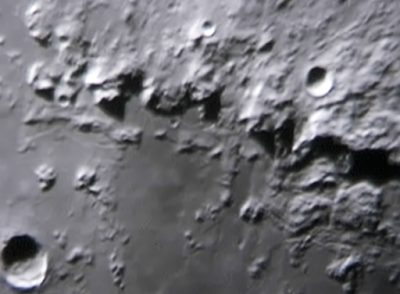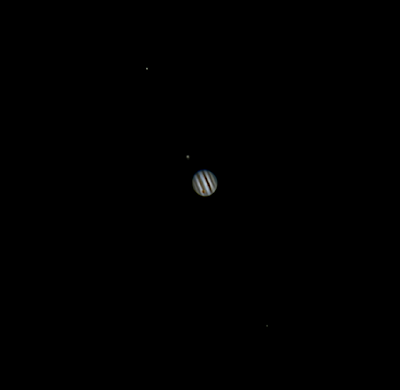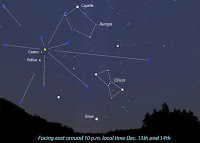All jokes aside, Uranus is a beautiful planet. It was once considered a gas giant like Jupiter and Saturn, but is now more commonly referred to as an ice giant, much like its nearest neighbor Neptune. Uranus has the coldest atmosphere of all the planets in our solar system, and has an estimated 27 satellites orbiting around it. Uranus also has its own set of rings, but unfortunately they are not nearly as noticeable as Saturn's famous rings.
This picture was taken on 12-17-15 with a Nexstar 6se and a Phillips spc900nc in Cathedral City, California.
The general purpose of this blog is to highlight the potential of astronomy and astrophotography in the Coachella Valley, CA and surrounding areas
Sunday, December 27, 2015
Saturday, December 19, 2015
Apollo 15 landing site
This image is of the Apollo 15 landing site, in a region known as Palus Putredinis in the eastern area of the Imbrium Basin. The image was taken with a Phillips SPC900nc and and Nexstar 6SE, seeing was average and there was some wispy clouds to work around.
Theophilus, Cyrillus, Catharna Moon craters
One of my personal favorite areas of the Moon is the 3 craters named Theophilus, Cyrillus, and Catharna. These set of impact craters lay between Sinus Asperitatis to the north, and Mare Nectaris to the south. Theophilus is the dominate crater, overlapping its neighbor Cyrillus. This image was taken on 12-16-15 with my newly acquired Phillips SPC900nc and my trusty Nexstar 6SE.
Jupiter, Europa, Io, Callisto and the great red spot
This picture is a stacked 3 minute video of Jupiter and 3 of its moons, Europa, Io, and Callisto. The software used includes Avistacks, Astra Image, and Photoshop. I recently came across the "holy grail" of telescope webcams, the Phillips SPC900nc and was blessed with near perfect seeing on 12-18-15 here in Cathedral City California. This webcam is amazing! The amount light it draws in, and the contrast is fantastic. My previous webcam was a Logitech HD c310, and I have to admit that the SPC900nc does a much better job.
As for Jupiter itself, it was shining at an apparent magnitude of -2.07. Europa is the top moon, followed by Io nearest to Jupiter, and Callisto is near the bottom. The great red spot is clearly visible in the image, as are the storm bands. The telescope used was a Celestron Nexstar 6SE.
As for Jupiter itself, it was shining at an apparent magnitude of -2.07. Europa is the top moon, followed by Io nearest to Jupiter, and Callisto is near the bottom. The great red spot is clearly visible in the image, as are the storm bands. The telescope used was a Celestron Nexstar 6SE.
Labels:
Amateur astronomy,
astronomy,
astrophotography,
Callisto,
Celestron,
Europa,
Gas giant,
great red spot,
Io,
Jupiter,
spc900nc
Monday, December 14, 2015
Orion Taurus and Pleiades M45 12-14-15
Lots to take in here, this picture is full of stars! We have the Orion constellation at the bottom, looking as beautiful as always. You can easily spot Betelgeuse, Bellatrix, and Rigel. Unfortunately, Saiph was just out of site, behind the house. The belt of Orion is also clearly visible. The stars that make up his belt are Alnitak, Alnilam, and Mintaka. The Orion Nebula is to the right of the belt, and is also referred to as Messier 42 or just M42.
The middle of the picture is dominated by the constellation Taurus, you can make out the head of the bull as a triangle near the middle of the image. This open cluster of stars is also known as Hyades. The largest star in the triangle is Aldebaran, shining at an apparent magnitude 0.84 tonight.
Next, we have the Pleiades, Seven Sisters M45 near the top of the picture. I've always looked at the Pleiades as a question mark in the sky. It is actually another open cluster in the Taurus constellation, and in fact has many more than just seven stars.
The middle of the picture is dominated by the constellation Taurus, you can make out the head of the bull as a triangle near the middle of the image. This open cluster of stars is also known as Hyades. The largest star in the triangle is Aldebaran, shining at an apparent magnitude 0.84 tonight.
Next, we have the Pleiades, Seven Sisters M45 near the top of the picture. I've always looked at the Pleiades as a question mark in the sky. It is actually another open cluster in the Taurus constellation, and in fact has many more than just seven stars.
This picture is a 10 second exposure, ISO 800, and taken with a Galaxy Note 5. I couldn't believe it myself, the fact that a phone can take pictures of the night sky like this is amazing. Post processing (minor brightness, contrast, de-blur/sharpening tweaks) was with Photoshop CS6 and Astra Image 4.0.
Image taken in Cathedral City, CA
Upcoming Star Party December 19 2015
The Astronomical Society of the Desert is holding a Star Party this coming weekend. They welcome anyone and everyone to come out and stargaze, from amateurs to professionals. The Star Parties are open to the public, and kid friendly. This is a great way to get your kids into Astronomy and the night sky. The fun begins at 5pm - 8pm at the Visitors Center, 51-500 Highway 74, Palm Desert, CA. Phone: 760-862-9984. Directions and information can be found here.
Guests are more than welcome to bring telescopes, binoculars, and other stargazing equipment, also note that telescopes and giant binoculars are also provided by ASOD members. Please also make sure to dress appropriately, as it has been quite chilly at night lately. The forecast as of this post does not look great, but keep an eye out over the next week. Let's hope for clear skies!
Guests are more than welcome to bring telescopes, binoculars, and other stargazing equipment, also note that telescopes and giant binoculars are also provided by ASOD members. Please also make sure to dress appropriately, as it has been quite chilly at night lately. The forecast as of this post does not look great, but keep an eye out over the next week. Let's hope for clear skies!
Sunday, December 13, 2015
Crescent Moon and Altair above the Coachella Valley 12-13-15
Tonight may call for clouds and rain, hampering the Geminid meteor shower, but that didn't stop a beautiful sunset and a crescent Moon from appearing over the Coachella Valley. Also making an appearance in this picture is Altair, shining at an apparent magnitude 0.75 tonight. Hopefully, the clouds will keep traveling and give us desert folk a nice view of the fireworks on display tonight.
Saturday, December 12, 2015
Enhancing Astrophotography pictures with Astra Image 4.0
Today I am going to discuss the benefits of using Astra Image to enhance astrophotography pictures. I came across this program a while back and have been successfully using it to enhance pictures of the Moon and Planets. It really does bring out the hidden details of the image by sharpening and enhancing contrast by a process called deconvolution.
First, lets talk about how I got the image. I use a Celestron Nexstar 6SE and a Galaxy Note 5 attached to a smart phone telescope adapter. I took a 3 minute video and then processed the video in Avistacks. The end result is this...
First, lets talk about how I got the image. I use a Celestron Nexstar 6SE and a Galaxy Note 5 attached to a smart phone telescope adapter. I took a 3 minute video and then processed the video in Avistacks. The end result is this...
Petavius (crater)
Friday, December 11, 2015
A Picture of Saturn on 7-22-15 Webcam + Telescope
I found a picture of Saturn that I took on 7-22-15 and wanted to share it. Saturn was at apparent magnitude 0.37 and was shining brightly towards the south. This image is actually a short 2-3 minute video taken with a Logitech c310 Webcam attached to my Celestron Nexstar 6SE and I used image stacking software later on by processing the video in Avistacks, this is the end results.
Labels:
astronomy,
astrophotography,
avistacks,
c310,
Celestron,
coachella valley,
logitech,
NASA,
nexstar,
Saturn,
Southern California,
video,
webcam
Thursday, December 10, 2015
Viewing Guide to the 2015 Geminid Meteor Shower in the Coachella Valley
Unfortunately, it looks like clouds and rain in the Coachella Valley for this years Geminid Meteor Shower. The meteor shower peaks on the night of the 13th into the pre-dawn hours of the 14th. The usual best viewing times for meteor showers is any time after midnight. As of today, the weather man is showing late night clouds and a chance of rain. We certainly need the rain out here, but I was really hoping for clear skies.
This years meteor shower is going to be a good one, with a maximum of 120 meteors per hour, weather and light pollution permitting of course. The night of the 13th and the night of the 14th will both offer great views of the meteors. If you would like more information on this years Geminid Meteor Showers you can read what NASA had to say here and here, and a great read here by Universe Today.

This years meteor shower is going to be a good one, with a maximum of 120 meteors per hour, weather and light pollution permitting of course. The night of the 13th and the night of the 14th will both offer great views of the meteors. If you would like more information on this years Geminid Meteor Showers you can read what NASA had to say here and here, and a great read here by Universe Today.

Wednesday, December 9, 2015
Sharpest ever view of the Andromeda Galaxy
I ran across this image the other day, captured with the NASA/ESA Hubble Space Telescope. This is simply the most beautiful picture of the Andromeda Galaxy, or any Galaxy for that matter, that I have ever seen. The full size original is a whopping 4.3 GB, but is completely worth every bit of bandwidth. This image shows over 100 million stars and thousands of star clusters, and I just can't stop looking at it! #Mindblown
You can download various sizes from the Spacetelescope.org website
You can download various sizes from the Spacetelescope.org website
Credit:
Sunspots 2418 and 2415 9-18-15
Viewing Sunspots through a telescope is a wonderful way to get some use out of your telescope during the daylight hours. As always, use caution when viewing the Sun. Always use a protective Sun filter for your telescope, and never look directly at the Sun with the unaided eye.
That being said, the Sun can be as equally rewarding to stargazers and astrophotographers as the stars and galaxies of the night sky. I took this picture on September 18th, 2015 and it highlights the Sunspots 2418 and 2415. For more information on these particular Sunspots you can head on over to Spaceweather Time Machine and take a more scientific look at the data available.
That being said, the Sun can be as equally rewarding to stargazers and astrophotographers as the stars and galaxies of the night sky. I took this picture on September 18th, 2015 and it highlights the Sunspots 2418 and 2415. For more information on these particular Sunspots you can head on over to Spaceweather Time Machine and take a more scientific look at the data available.
Equipment used: Celestron Nexstar 6SE + Solar filter + Galaxy Note 5
Orion Constellation in Cathedral City 12-4-15
Snapped a picture of the Orion Constellation from my back yard in Cathedral City on 12-4-15 at about 2:30 am. A few stubborn wispy clouds got in the way, but the picture still turned out well. Betelgeuse is the dominate star in this picture, for good reason. Betelgeuse is about 642.5 light years away from us, and is roughly 5-30 times the mass of our Sun(seems they are still working on this number). It is classified as a red super-giant, and is defiantly one of the largest and most luminous observable stars in our night sky. This article here from EarthSky explains that someday Betelgeuse will go all supernova and that "It will run out of fuel, collapse under its own weight, and then rebound in a spectacular supernova explosion. When this happens, Betelgeuse will brighten enormously for a few weeks or months, perhaps as bright as the full moon and visible in broad daylight." Exciting times indeed!
Tuesday, December 8, 2015
Orion Nebula M42 at the Joshua Tree National Park - 11-2-15
I recently went to the Joshua Tree National Park and snapped some amazing pictures of the Orion Nebula M42. If you have never been to the Joshua Tree National Park I highly recommend it. It is a stones throw away from the Coachella Valley and it offers some of the best night sky views in the area. We usually end up at the southern entrance and camp in the Cottonwood campground, but this time we traveled much deeper into the park and stayed at the Jumbo Rock campground. The views of the Milky Way are fantastic here, and the light pollution from the surrounding areas was at a minimum. It was a much colder night than we anticipated, and the wind was a big factor, but the sky was clear so we had that going for us. The Joshua Tree National Park is home to all kinds of Astronomy related activities, such as star parties, and guided night tours of the desert. You really should check it out sometime.
Without further ado, here is the picture of the lovely Orion Nebula M42 at the Joshua Tree National Park...
Without further ado, here is the picture of the lovely Orion Nebula M42 at the Joshua Tree National Park...
Equipment used: Celestron Nexstar 6SE + Galaxy Note 5 -- 10 sec exposure 800 iso
Monday, December 7, 2015
Total Lunar Eclipse - 9/28/15
I figured since I used one of my lunar eclipse pictures as my header image, I might as well post a few more from that night. These pictures were taken during this years spectacular total lunar eclipse that occurred on September 28th. My wife and I set up the telescope in the front yard and waited for the Moon to rise. I was actually surprised and extremely excited to see a few neighbors also outside staring up in anticipation. By the time the Moon had risen above the palm trees and neighbors houses the eclipse was already underway, but I knew this was going to be the case beforehand with southern California in general. The equipment used was a Celestron Nexstar 6SE and a HTC EVO + Cell Phone Adapter Mount.
Conjunction of the Moon and Venus 12/7/2015
This morning 12/7/2015 was the 2015 Conjunction of the Moon and Venus. It occurred locally in the Coachella Valley at about 8:00 am. I was able to catch a few pictures in between wispy clouds, and it turned out to be a beautiful sight indeed.
Introductions...
Introductions are in order, this being my first official post and all. Hello, and welcome to the Coachella Valley Astronomy and Astrophotography blog. My name is Michael Roemelen and I live in the Coachella Valley. I have been an avid amateur stargazer for years now and just recently got into taking pictures of the beautiful night skies here in the Coachella Valley and surrounding areas. I am going to take a guess here, and say that you have landed on my blog because you have an interest in Astronomy and/or Astrophotography in or around the Coachella Valley. Fantastic! Me too!
My purpose for creating this blog is to share with the world my personal pictures of the night skies. I have posted many important links that I personally use and I plan on updating the site with new and exciting pictures whenever I can. So, please feel free to stop by and utilize the links and widgets available on the site. There are links to ISS sightings, moon phases, stargazing tours, clear sky data, celestial events, and others pertaining to the Coachella Valley and Southern California.
My purpose for creating this blog is to share with the world my personal pictures of the night skies. I have posted many important links that I personally use and I plan on updating the site with new and exciting pictures whenever I can. So, please feel free to stop by and utilize the links and widgets available on the site. There are links to ISS sightings, moon phases, stargazing tours, clear sky data, celestial events, and others pertaining to the Coachella Valley and Southern California.
Subscribe to:
Posts (Atom)



















